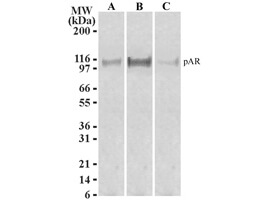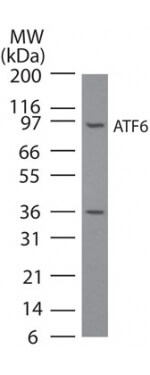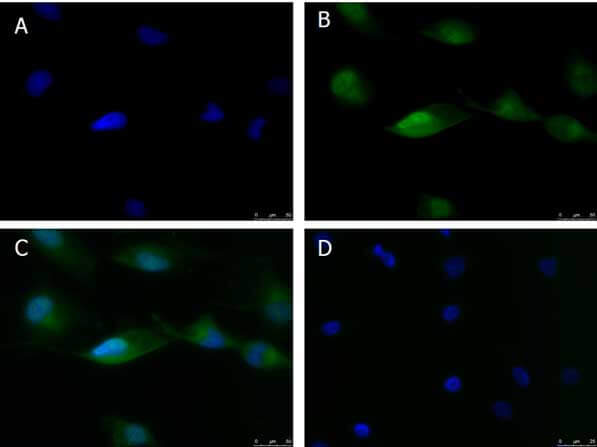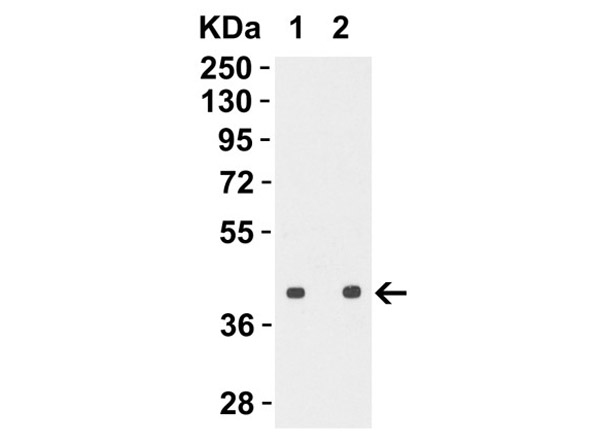Datasheet is currently unavailable. Try again or CONTACT US
ATF6 Antibody
Mouse Monoclonal 70B1413.1 IgG1 kappa
200-301-H56
100 µg
Liquid
WB, IHC, IF, FC, ChIP, IP
Human, Mouse
Mouse
Shipping info:
$50.00 to US & $70.00 to Canada for most products. Final costs are calculated at checkout.
Product Details
Anti-ATF6 (MOUSE) Monoclonal Antibody - 200-301-H56
Activating transcription factor 6 alpha
Mouse
Monoclonal
IgG1
Target Details
ATF6 - View All ATF6 Products
Human, Mouse
Conjugated Peptide
ATF6 Antibody was produced in mice by repeated immunizations with the partial protein of human ATF6 at the n-terminus of the protein.
Anti-ATF6 Antibody was purified by Protein G chromatography. A BLAST analysis was used to suggest cross-reactivity with Anti-ATF6 from Grouper (Fish), Hamster, Human, Mouse, Rabbit, and Rat based on 100% homology with the immunizing sequence. Cross-reactivity with Anti-ATF6 from other sources has not been determined.
Application Details
ChIP, FC, IF, IHC, IP, WB
Anti-ATF6 antibody is tested for use in WB, ChIP, Flow, Flow-IC, ICC/IF, IHC-Fr, IHC-P, and IP. Expect a band approximately 90 kDa on specific lysates. Specific conditions for reactivity should be optimized by the end user.
Formulation
1.0 mg/mL by UV absorbance at 280 nm
0.02 M Potassium Phosphate, 0.15 M Sodium Chloride, pH 7.2
0.05% (w/v) Sodium Azide
0.05% BSA
Shipping & Handling
Dry Ice
Store vial at -20° C prior to opening. Aliquot contents and freeze at -20° C or below for extended storage. Avoid cycles of freezing and thawing. Centrifuge product if not completely clear after standing at room temperature. This product is stable for several weeks at 4° C as an undiluted liquid. Dilute only prior to immediate use.
Expiration date is one (1) year from date of receipt.
Anti-ATF6 antibody detects human ATF6. ATF6 is a constitutively expressed, endoplasmic reticulum (ER) membrane-anchored transcription factor. ATF6 is a key transcriptional activator of the unfolded protein response (UPR), which allows mammalian cells to maintain cellular homeostasis when they are subjected to environmental and physiological stresses that target the ER. The C-terminus of ATF6 is located in the ER lumen and its N-terminal DNA binding domain faces the cytosol. AFT6 plays a key role in the ER stress response by transmitting the ER stress signal across the ER membrane into the nucleus. The induction of new gene expression by ATF6 is an important aspect of the ER stress response. In response to certain stress conditions, ATF6 translocates from the ER to the Golgi. The 90 kDa full-length ATF6 is processed within the Golgi to its active 50 kDa form through sequential cleavage by site-1 and site-2 proteases (S1P and S2P). Proteolytic activation of ATF6 in the ER stress response is a mechanism to regulate membrane-bound factors, and is referred to as regulated intramembrane proteolysis. The N-terminal active ATF6 translocates to the nucleus where it binds to ER stress-response elements in ER stress-response genes (ERSRGs). ATF6 is a potent transcriptional activator of ERSRGs. The fully glycosylated form of ATF6, a 670 amino acid protein, exhibits an electrophoretic mobility of ~90 kDa in denaturing SDS-gels, in part because of the glycosylated modifications. ATF6 has 3 consensus sites for N-linked glycosylation and exists constitutively as a glycosylated protein. Differentially glycosylated ATF6 forms may result from mutations or experimental treatment. Anti-ATF6 antibody is ideal for investigators involved in apoptosis research.
This product is for research use only and is not intended for therapeutic or diagnostic applications. Please contact a technical service representative for more information. All products of animal origin manufactured by Rockland Immunochemicals are derived from starting materials of North American origin. Collection was performed in United States Department of Agriculture (USDA) inspected facilities and all materials have been inspected and certified to be free of disease and suitable for exportation. All properties listed are typical characteristics and are not specifications. All suggestions and data are offered in good faith but without guarantee as conditions and methods of use of our products are beyond our control. All claims must be made within 30 days following the date of delivery. The prospective user must determine the suitability of our materials before adopting them on a commercial scale. Suggested uses of our products are not recommendations to use our products in violation of any patent or as a license under any patent of Rockland Immunochemicals, Inc. If you require a commercial license to use this material and do not have one, then return this material, unopened to: Rockland Inc., P.O. BOX 5199, Limerick, Pennsylvania, USA.






